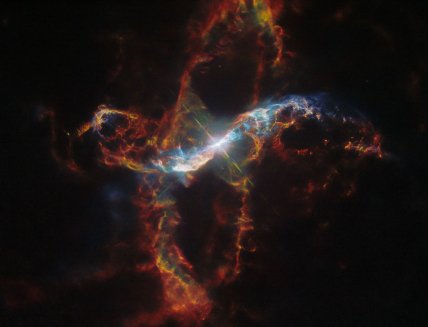Galactic passion: The explosive dance of two stars captured by the Hubble Telescope (photos, videos).
The Hubble Space Telescope, despite its venerable age and the existence of more modern counterparts, continues to delight space enthusiasts with its stunning photographs. This time, it captured a dramatic scene of one of the most unstable star pairs in our home galaxy.
This refers to R Aquarii, which ejects long, glowing strands of luminous gas into the void. The colorful image was shared by the Hubble team on their website.
Scientists who examined the photograph compared it to a volcano or a functioning garden sprinkler. The image reveals the effects of nuclear processes occurring within the star, expelling the resultant products into space.

R Aquarii is located 700 light-years from Earth and is a binary star system. The primary star is an old red giant, which is over 400 times larger than the Sun and reaches a peak brightness that is five thousand times greater than that of our star. However, it cannot be considered stable, as its brightness and temperature can fluctuate by as much as 750 times during a 390-day cycle.
It is no surprise that life with such a "temperamental" partner led to the dimming of the other star in the system—a white dwarf, which is now doomed to complete an orbit around the larger celestial body every 44 years.
Nevertheless, the gravity of the smaller star is still strong enough to significantly impact the ongoing life of this peculiar pair. At its closest approach, the white dwarf pulls hydrogen from the red giant and accumulates it on its surface, triggering nuclear fusion. Ultimately, the energy builds up to such an extent that a tremendous explosion occurs, and the cycle begins anew.
It is the remnants of this explosion that the Hubble team was able to observe. According to their calculations, the plasma from the ejection is moving at speeds exceeding one and a half million kilometers per hour. This means it could cover the distance from the Moon to Earth in just 15 minutes. Furthermore, the force is sufficient to eject superheated gas up to 400 billion kilometers away from the stars, which is roughly 24 times the diameter of our Solar System.
Hubble first observed these stars in 1990, and even then, scientists realized that the scale of the events taking place is extraordinary, even by astronomical standards.
In the video below, you can see a brief segment showing what happened to the stars between 2014 and 2023.
As previously reported, NASA is preparing to launch a mission to search for life in the Solar System. They intend to look not on Mars, but on one of Jupiter's moons.